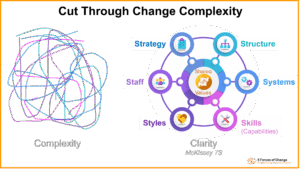Shifting Beliefs to Improve Results at Work
Dramatic improvement in results at work required large-scale change in behaviours. This means shifting people’s beliefs (see my previous article). And, whilst beliefs are difficult to change, when they do change it has a significant and lasting effect on outcomes.
Why are beliefs so hard to shift?
 Changing your beliefs is a costly business. It takes great effort to rewire your thinking. Beliefs are often deeply embedded in our subconscious and in our own sense of who we are. So, changing your mind and admitting your beliefs were wrong or out-dated goes against our own sense of identity, not to mention losing face or feeling stupid.
Changing your beliefs is a costly business. It takes great effort to rewire your thinking. Beliefs are often deeply embedded in our subconscious and in our own sense of who we are. So, changing your mind and admitting your beliefs were wrong or out-dated goes against our own sense of identity, not to mention losing face or feeling stupid.
On the other hand, it would be a strange and chaotic world if which we all changed our beliefs on a daily basis. Our brains have evolved to maintain equilibrium, and it provides mechanisms to help us preserve the status quo. For instance, we naturally seek out ways to justify our beliefs, even in the face of evidence to the contrary. People who over-eat may tell themselves that ‘life is for living’, despite clear evidence that they are putting their health at risk. Others tell themselves that they are skilful drivers to justify breaking the speed limit. And at work, when presented with clear evidence of the need for fundamental change, people are likely to challenge the data or the competence of the person presenting it, as well as finding reasons why the proposed changes simply won’t work.
Alarmingly, over the past few years, we have seen conspiracy theories gain widespread credence, especially in the US, leading ultimately to the storming of the Capitol building on 6th January 2021 in protest against a ‘stolen election’. Such beliefs are particularly fixed as they offer new attachments and new self-identities imbued with powerful affiliations, validation, esteem and sense of purpose than the individual previously had in their life.
Shifting unhelpful beliefs at work
Given the natural ‘stickiness’ of beliefs, and our predisposition to protect the status quo, changing beliefs can be a daunting prospect. Nonetheless, it is often what stands between us and game-changing improvements in performance.
So, where should we begin?
Let’s start with some useful principles. Firstly, people need to decide for themselves to change. This is a fundamental precept of change – you cannot make up people’s minds for them (or rarely is it possible to do so); they need to reach their own conclusions. By the same token, you need to make up your own mind whether this is a useful principle! In practice, this mean helping people to think through the issues in hand – assessing the facts, and drawing their own conclusions about the desirability of change. The second principle is to work on this as a team – discussing issues and analyzing the facts together, through dialogue, creates common understanding and leverages peer pressure to encourage more reluctant members of the team. The final principle is that leaders in the organisation must act as role models for the new ways of thinking and behaving – another fundamental principle of successful organisational change.
 It is helpful to begin the process by working with people to explore how we as humans have a natural tendency to stick with our current behaviours, based on current beliefs e.g. the belief that you are ‘better than average driver’. From there, we can proceed to work-based examples. For instance, if we were looking at unsafe habits on a construction site, we might examine people’s habit of walking around site whilst talking on a mobile phone. We could explore data demonstrating that such a habit puts you in danger of accident, injury or even death. Next, people can examine their unhelpful beliefs, such as “I am able to multi-task” or “I have important calls to make that cannot wait for me to be sat in an office”. They can then work together to create new, shared, more helpful beliefs and a new set of agreed behaviours. For instance, a new belief that “Talking on mobile phones is distracting and leads to an increased chance of an accident at work”, and new, agreed behaviours that “We will only talk on mobile phones in the office or off site.”
It is helpful to begin the process by working with people to explore how we as humans have a natural tendency to stick with our current behaviours, based on current beliefs e.g. the belief that you are ‘better than average driver’. From there, we can proceed to work-based examples. For instance, if we were looking at unsafe habits on a construction site, we might examine people’s habit of walking around site whilst talking on a mobile phone. We could explore data demonstrating that such a habit puts you in danger of accident, injury or even death. Next, people can examine their unhelpful beliefs, such as “I am able to multi-task” or “I have important calls to make that cannot wait for me to be sat in an office”. They can then work together to create new, shared, more helpful beliefs and a new set of agreed behaviours. For instance, a new belief that “Talking on mobile phones is distracting and leads to an increased chance of an accident at work”, and new, agreed behaviours that “We will only talk on mobile phones in the office or off site.”
Once new beliefs and agreed behaviours are established, work can begin on creating a ‘new normal’. This can be achieved in a variety of ways. For instance, giving permission to everyone to challenging each other to live up to their agreement, including encouraging front-line workers to challenge their bosses if they spot them walking around site talking on their phone. Continuous reminders, visual cues and ongoing communication, as well as all leaders demonstrating their commitment to change through their own actions, are also useful in re-enforcing and embedding new beliefs and behaviours.
Learn More
For more on shifting Mindsets see the ‘The Leading Successful Change‘ eLearning course or the two books: ‘The 5 Forces of Change – a blueprint for leading successful change’ and ‘5 Tales of Change – how people have wrestled with change and one’, available in paperback and Kindle editions.








